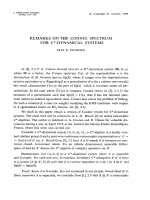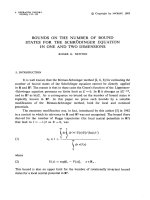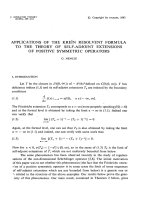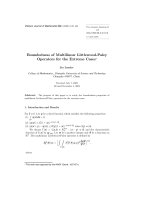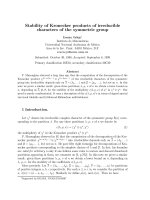Báo cáo toán học: " ASYMPTOTICS OF THE NUMBER OF k-WORDS WITH AN -DESCENT" pot
Bạn đang xem bản rút gọn của tài liệu. Xem và tải ngay bản đầy đủ của tài liệu tại đây (102.43 KB, 4 trang )
ASYMPTOTICS OF THE NUMBER OF
k-WORDS WITH AN -DESCENT
Amitai Regev
∗
Department of Mathematics
The Pennsylvania State University
University Park, PA 16802, U.S.A
E-mail:
and
Department of Theoretical Mathematics
The Weizmann Institute of Science
Rehovot 76100, Israel
E-mail:
Submitted: December , 1997; Accepted: February 25, 1998
Abstract. The number of words w = w
1
···w
n
,1≤ w
i
≤ k,
for which there are 1 ≤ i
1
< ···<i
≤ n and w
i
1
> ···>w
i
,
is given, by the Schensted-Knuth correspondence, in terms of
standard and semi-standard Young tableaux. When n →∞,
the asymptotics of the number of such words is calculated.
∗
Work partially supported by N.S.F. Grant No. DMS-94-01197.
Typeset by A
M
S-T
E
X
1
2
The Main Results.
Let k, n > 0 be integers and let W (k; n)=
w
1
···w
n
1 ≤ w
i
≤ k for all 1 ≤ i ≤ n
denote the set of words of length n on the alphabet {1, ···,k}.Awordw = w
1
···w
n
∈
W (k, n) is said to have a descent of length if there exist indices 1 ≤ i
1
< ···<i
≤ n
such that w
i
1
> ···>w
i
(trivially, such words exist if and only if ≤ k).
Let W(k, ; n) denote the set of words in W(k; n) having descent ≤ , and denote
w(k, ; n)=|W (k, ; n)|.ThusW (k; n)=W (k, k; n), and w(k, k; n)=k
n
.
Recall: given two sequences {a
n
} and {b
n
} of real numbers, we denote a
n
n→∞
b
n
(or
simply a
n
b
n
) if lim
n→∞
a
n
b
n
=1.
The main result here is
Theorem 1. Let 1 ≤ ≤ k,then
w(k, ; n)
n→∞
1!2! ···( − 1)!
(k − )! ···(k − 1)!
·
1
(k−)
· n
(k−)
·
n
Remark.
1!···(−1)!
(k−)!···(k−1)!
=
k!!
!!(k−)!!
−1
,wherem!!
def
=1!2!···(m −1)!
Standard and Semistandard Tableaux.
Let λ n (i.e. λ is a partition of n). A tableau of shape λ, filled with 1, ···,n,
is standard if the numbers in it are increasing both in rows and in columns. Let d
λ
denote the number of such tableaux. It is well known that d
λ
=deg(χ
λ
), where χ
λ
is the
corresponding irreducible character of the symmetric group S
n
.
A k-tableau of shape λ is a tableau filled with 1, ···,k possibly with repetitions; it
is semi-standard if the numbers are weakly increasing in rows and strictly increasing in
columns. Let s
k
(λ) denote the number of such k-tableaux. It is well known that s
k
(λ)is
the degree of a corresponding irreducible character of GL(k, C) (or of SL(k, C)).
The numbers w(k, ; n) are given by
Theorem 2. Let ∧
(n)=
(λ
1
,λ
2
, ···) n
λ
+1
=0
.Then
w(k, ; n)=
λ∈∧
(n)
s
k
(λ) ·d
λ
.
Formulas for calculating d
λ
’s and s
k
(λ)’s are well known. Here we shall need the fol-
lowing formula:
Let λ =(λ
1
,λ
2
, ···). If λ
k+1
> 0thens
k
(λ) = 0. Assume λ
k+1
=0. Then
s
k
(λ) = [1!2! ···(k − 1)!]
−1
·
1≤i<j≤k
(λ
i
−λ
j
+ j − i)(∗)
3
We turn now to the proofs of Theorems 1 and 2, starting with
The proof of Theorem 2:
Apply the Schensted-Knuth correspondence [K] to w ∈ W (k; n):w → (P
λ
,Q
λ
), where
P
λ
and Q
λ
are tableaux of same shape λ, Q
λ
is standard and P
λ
is k-semistandard. This
gives a bijection
W (k; n) ↔{(P
λ
,Q
λ
)
λ ∈∧
k
(n),P
λ
is k-semistandard,Q
λ
is standard}.
Moreover, let w ↔ (P
λ
,Q
λ
) under this correspondence, then w has a descent of length ≥ r
if and only if λ
r
0. It clearly follows that the Schensted-Knuth correspondence gives a
bijection
W (k, ; n) ↔{(P
λ
,Q
λ
)
λ ∈∧
(n),P
λ
is k-semistandard,Q
λ
is standard}.
Hence
w(k, ; n)=
λ∈Λ
(n)
s
k
(λ)d
λ
Q.E.D.
Remark. Let 1 ≤ ≤ k and let λ ∈∧
(n), then it is easy to verify that (∗) implies that
s
k
(λ)=a ·b · c (∗∗)
where a =[(k − )! ···(k − 1)!]
−1
, b =
1≤i≤
+1≤j≤k
(λ
i
+ j − i)
and
c =
1≤i<j≤
(λ
i
− λ
j
+ j − i).
The Proof of Theorem 1.
Heretheresultsof[C.R]areapplied.Letλ ∈∧
(n), 1 ≤ ≤ k, and write:
λ =(λ
1
, ···,λ
)=(λ
1
, ···,λ
k
), where λ
+1
= ···= λ
k
=0.
Also write λ
j
=
n
+ c
j
√
n. By the notations of [C.R], the factors b and c of (∗∗)satisfy
b ≈
1≤i≤
n
k−
=
n
(k−)
and
c ≈
1≤i<j≤
(c
i
− c
j
)
(
√
n)
(−1)
2
.
4
Thus
s
k
(λ) ≈ [(k − )! ···(k − 1)!
(k−)
]
−1
·
1≤i<j≤
(c
i
− c
j
)
· n
(k−)+
(−1)
4
.
Apply now [C.R. Theorem 2] with β =1(also replacing k and s
k
(λ) replacing f(λ)):
w(k, ; n)=
Thm 1
λ∈∧
(n)
s
k
(λ)d
λ
[(k − )! ···(k − 1)! ·
(k−)
]
−1
·
1
√
2π
−1
·
1
2
2
· n
(k−)
·
n
· I
,
(∗∗∗)
where
I
=
···
x
1
+···+x
=0
x
1
≥···≥x
1≤i<j≤
(x
i
− x
j
)
2
exp
−
2
j=1
x
2
j
d
(−1)
x.
Special Case:Let = k.Thenw(k, k; n)=k
n
. Cancelling k
n
from both sides of
(∗∗∗) implies that
I
k
= [1!2! ···(k − 1)!]
√
2π
k−1
·
1
k
1
2
k
2
(Note: by [R, §4] I
k
can also be calculated by the Mehta-Selberg integral).
In particular,
I
= [1!2! ···( − 1)!]
√
2π
−1
·
1
1
2
2
.
Substituting for I
in (∗∗∗) implies that
w(k, ; n)
1!2! ···( − 1)!
(k − )! ···(k − 1)!
·
1
(k−)
· n
(k−)
·
n
which completes the proof of Theorem 1. Q.E.D.
Acknowledgement. I am thankful to Dr. H. Wilf for suggesting this problem.
References
[C.R] P.S.Cohen,A.Regev,Asymptotics of combinatorial sums and the central limit theorem, SIAM J.
Math. Anal., Vol 19, No 5 (1980) 1204–1215.
[K] D. E. Knuth, The Art of Computer Programming, Vol. 3, Addison-Wesley, Reading, Mass., 1968.
[R] A. Regev, Asymptotic values for degrees associated with strips of Young diagrams, Adv. in Math.
41 (1981), 115–136.
